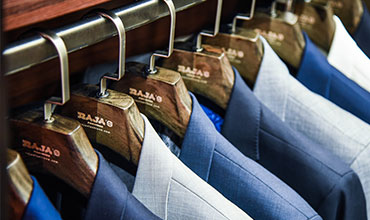We all have classic pieces in our wardrobe that never seem to go out of fashion. Most of us will wear 20% of our clothing 80% of the time – this is the Pareto Principle and how it applies specifically to fashion. How does this pertain to your wardrobe and suits? You’re likely to have a handful of shirts, suits, trousers, ties and socks that you wear most often. These are the essential items and we’re going to show you how to apply the 80/20 rule for looking fabulous with only a few pieces from your collection
Building Blocks: The Suit
Imagine you get a sudden call for a business meeting and have to get ready in a moment’s notice. But you only own one suit. Picture what it looks like and you’ll know what the most important suit in your wardrobe is.
The 20% Rule: Choose charcoal grey, black or a navy-blue jacket to build your wardrobe around. Matching trousers for each is a must. Play with your pattern and fabric choices to give your outfits a creative edge.
The Essentials: Dress Shirts
Most men will wear their favorite dress shirt the most often. That’s the 80/20 rule at play. Let’s suppose you can only own three dress shirts. Two should be in solid colors while you can be liberal with pattern choices and shades of the third.
The 20% Rule: White, shades of light blue and pink are your best choices for the solid color shirts. Ensure that they match with the suits you have (refer above) and that the collars fit your facial structure. For the patterned shirt, choose one that you can wear with jeans, chinos or shorts so that you have a casual, dressier option as well.
The Footwear
Shoes are arguably the easiest part of applying the Pareto principle to your wardrobe. If you can only own one pair, black leather (laced) shoes are the undisputed winners. Whether you’re at work, formal parties, dinners or funerals, they’ll fit in with your outfit. Shine and polish regularly to extend your shoes’ longevity.
The 20% Rule: Black doesn’t mean boring. A pair of Chelsea boots or Oxfords keep it classy and timeless. You’ll be wearing this pair with most of your outfits, so choose one that’s comfortable and fits well. Got room for one more? They should be brown, especially if your primary suit is in navy blue.
Ties
Ties are often the trickiest part of an ensemble, especially for when you only have a couple of choices. When you buy your ties, remember that you’ll be wearing your favorites 80% of the time. First, pick two in dark colors and two in lighter shades. Then, choose two in patterns like striped, plaid, paisley or club patterns in blue, red, gold or black.
The 20% Rule: When you’re shopping for ties, have an idea of what they’ll look like with your suits and shirts (remember the colors we mentioned above). They should match the dress shirts and jackets that you wear most often. Pick one dressier tie that you can wear with your shirts for parties and casual events.
Vary Your Look with The Basics
We’re going to show you how to dress in four different styles with the same suit jacket. Suppose you have a charcoal jacket in a classic worsted wool fabric. Here’s how to play with it.
The Professional: Full Suit with a pale blue shirt. Dress it with a tie in a darker shade of blue and a pocket square. Sport your black leather shoes for a look that’s perfect for formal events and business situations.
Smart & Casual: Same charcoal blazer, but sport with black chinos and a white t–shirt. You can lose the leather shoes and wear sneakers (a pair of black Chelsea boots would be perfect).
Time for Denim: Instead of chinos, wear your favorite pair of jeans. A white dress shirt or checkered shirt works great. Loafers or dress shoes – you could swing either way in the footwear department.
Round Neck: Choose any round neck t–shirt in a light shade of grey. Sport with black or white chinos with loafers for a groovy, club–night look.
You wear 20% of your suits, shirts, ties and shoes 80% of the time. Use the guide above to create a wardrobe that’s full of the essential pieces which can provide you with a variety of looks, from smart-casual to formal. If you’re looking to save money, minimize clutter in your wardrobe or simply want to learn how to dress up your existing clothes, this article outlines exactly what you need.
